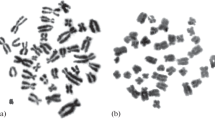Abstract
Twelve synaptonemal complexes are present in both oocyte and spermatocyte pachytene nuclei ofAscaris lumbricoides var.suum, as determined by 3-D reconstruction of the nuclear contents from electron microscopy of serial sections and therefore, n=12 in the strain ofAscaris described here. In the female the heterochromatic end of each synaptonemal complex is attached to the nuclear envelope and the other end is free in the nucleoplasm. In the male neither end ot the synaptonemal complex is attached, but there is a heterochromatic knob at one end of each complex. Five additional large heterochromatic masses are present in the spermatocyte nucleus and these may be the sex chromosomes described by earlier workers.
Similar content being viewed by others
Literature Cited
Bonnevie, K.: Über Chromatindiminution bei Nematoden. Jena Z. Naturwiss.36, 275–288 (1902)
Boring, A.: A small chromosome in Ascaris megalocephala. Arch. Zellforsch.2, 66–75 (1909)
Boveri, Th.: Über Differenzierung der Zellkerne während der Furchung des Eies von Ascaris megalocephala. Anat. Anz.2, 688–693 (1887)
Carpenter, A.: Electron microscopy of meiosis in Drosophila melanogaster females. I. Structure, arrangement, and temporal change of the synaptonemal complex in wild-type. Chromosoma (Berl.)51, 157–182 (1975)
Clark, W., Moretti, R., Thomson, W.: Histochemical and ultracytochemical studies of the spermatids and sperm of Ascaris lumbricoides var. suum. Biol. Reprod.7, 145–159 (1972)
Edwards, C.: The idiochromosomes in Ascaris megalocephala and Ascaris lumbricoides. Arch. Zellforsch.5, 422–429 (1910)
Fiske, S.: An adaptation of Reynold's lead citrate stain for high resolution autoradiography. J. Microscopie5, 355–360 (1966)
Foor, W.E.: Zygote formation in Ascaris lumbricoides. J. Cell Biol.39, 119–134 (1968)
Gillies, C.B.: Synaptonemal complex and chromosome structure. Ann. Rev. Genet.9, 91–109 (1973)
Gillies, G.B.: An ultrastructural analysis of chromosome pairing in maize. C.R. Lab. Carlsberg40, 135–161 (1975)
Goldstein, P.: Chromatin diminution in early embryogenesis of Ascaris lumbricoides var. suum. J. Morph. (in press, 1976)
Jeffrey, E., Haertl, E.: The nature of the so-called sex chromosomes in Ascaris. La Cellule46, 237–245 (1938)
Kaulenas, M., Fairbairn, D.: RNA metabolism of fertilized Ascaris lumbricoides eggs during uterine development. Exp. Cell Res.52, 233–251 (1968)
Koidzumi, M., Kiraschi, S., Koino, H.: Trop. Dis. Bull.24, (1962), cited from Kurashvili (1965)
Kurashvili, B., Pchakadze, G., Shengelia, F.: Some data on cytological studies on Ascaris lumbricoides and Ascaris suum. Soviet Genetics1, 252–259 (1965)
Lin, T.P.: The chromosomal cycle in Parascaris equorum (Ascaris megalocephala): Oogenesis and diminution. Chromosoma (Berl.)6, 175–198 (1954)
McClung, C.: The accessory chromosome-sex determinant? Biol. Bull.3, 43–84 (1902)
Moens, P.B.: Quantitative electron microscopy of chromosome organization at meiotic prophase. Cold Spr. Harb. Symp. quant. Biol.38, 99–107 (1973)
Moens, P.B., Perkins, F.O.: Chromosome number of a small protist: Accurate determination. Science166, 1289–1291 (1969)
Montgomery, T.: On the morphological differences of the chromosomes of Ascaris megalocephala. Arch. Zellforsch.2, 66–75 (1909)
Vassilev, I., Mutafova, T.: Comparative studies on the karyotype of Ascaris suum and Ascaris ovis. Z. Parasitenk.43, 115–121 (1974)
Walton, A.C.: Some parasites and their chromosomes. J. Parasit.45, 1–20 (1959)
Westergaard, M., Wettstein, D. von: The synaptinemal complex. Ann. Rev. Genet.6, 71–110 (1972)
Woollam, D., Millen, J., Ford, E.: Points of attachment of pachytene chromosomes to the nuclear envelope in mouse spermatocytes. Nature (Lond.)213, 298–299 (1969)
Zickler, D., Olson, L.: The synaptonemal complex and the spindle plaque during meiosis in yeast. Chromosoma (Berl.)50, 1–23 (1975)
Zur Strassen, O.: Über die Riesenbildung bei Ascaris Eiern. Wilhelm Roux' Arch. Entwickl. Mech. Org.7, 642–676 (1899)
Author information
Authors and Affiliations
Rights and permissions
About this article
Cite this article
Goldstein, P., Moens, P.B. Karyotype analysis ofAscaris lumbricoides var.suum . Chromosoma 58, 101–111 (1976). https://doi.org/10.1007/BF00701353
Received:
Accepted:
Issue Date:
DOI: https://doi.org/10.1007/BF00701353




